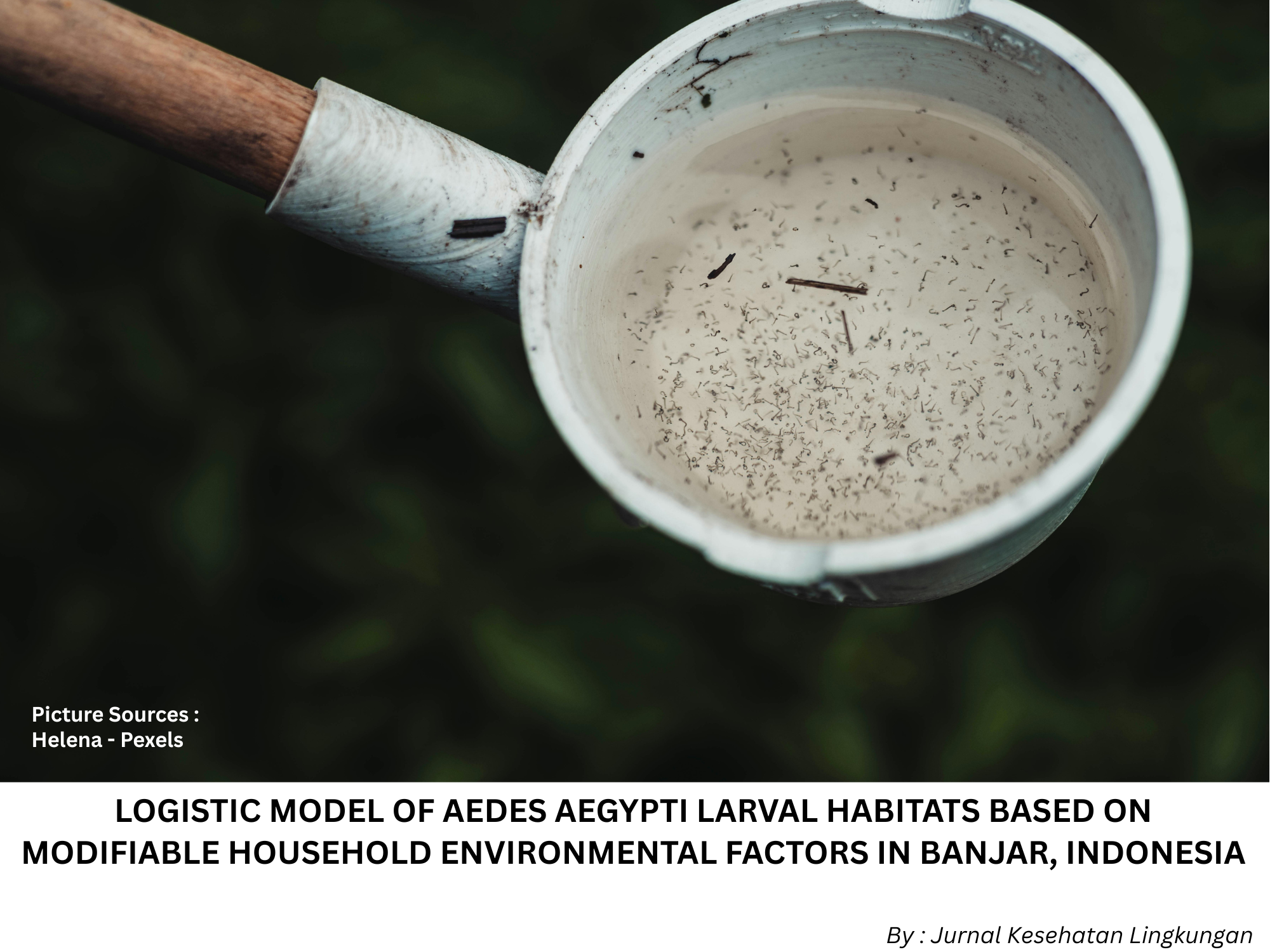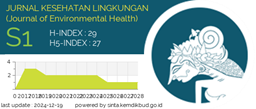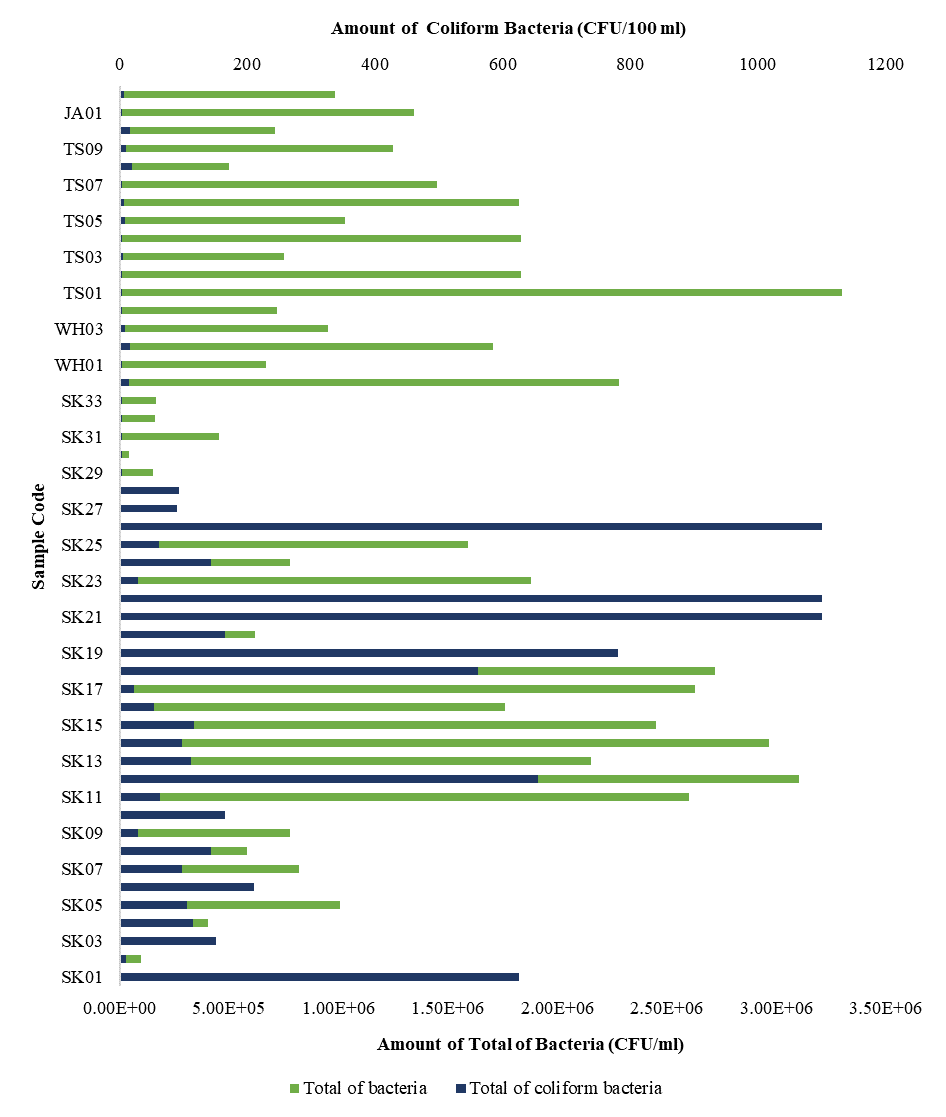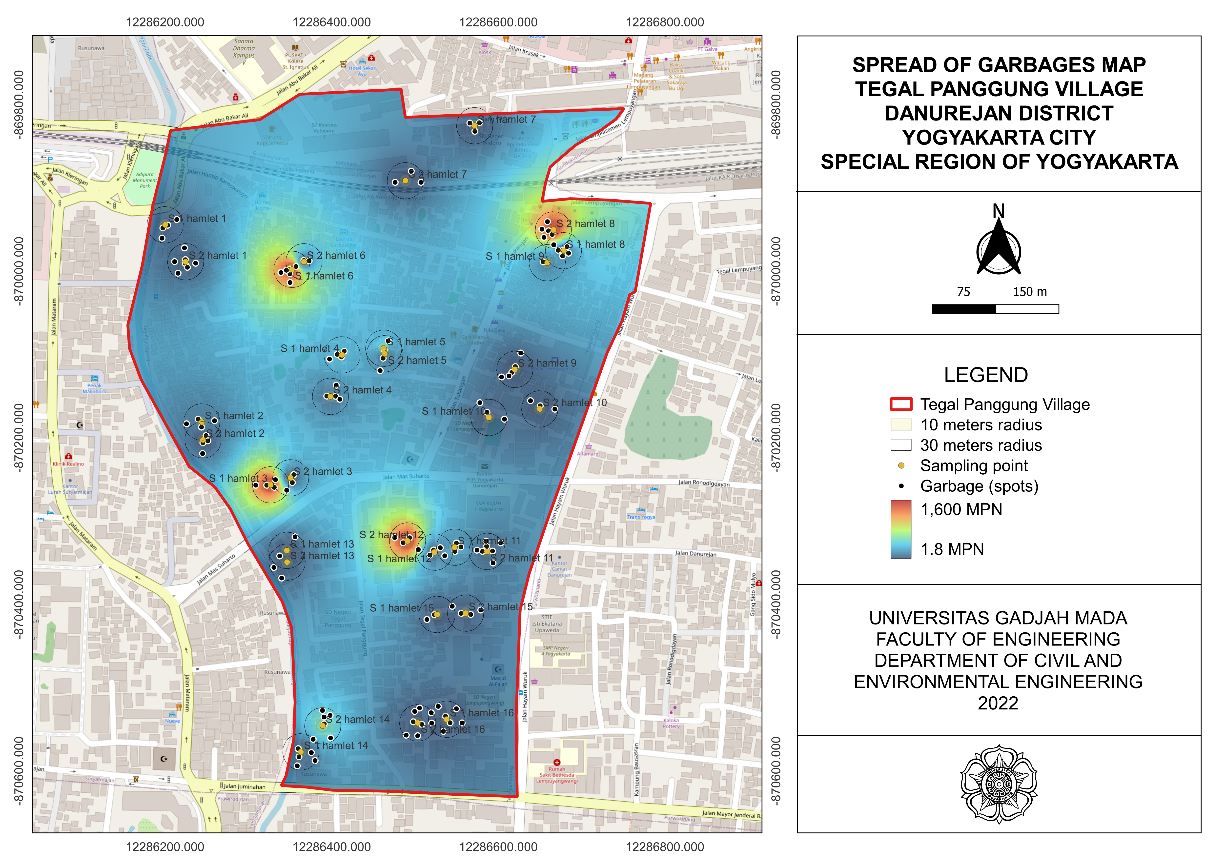Logistic Model of Aedes Aegypti Larval Habitats Based on Modifiable Household Environmental Factors in Banjar, Indonesia

Downloads
Introduction: In endemic nations like Indonesia, dengue fever remains a serious public health concern. The majority of predictive models ignore modifiable risk factors at the home level in favor of macroenvironmental variables (rainfall and climate). The study aimed to develop a logistic regression model to forecast the presence of Aedes aegypti larvae based on water quality metrics and the household water containers characteristics. Methods: In Banjar Regency, Indonesia, 400 randomly chosen households participated in a cross-sectional survey. Water parameters (pH, temperature, salinity, and dissolved oxygen) and container attributes (color, cover availability, and type of water source) were evaluated. Significant predictors were identified using stepwise logistic regression. Model performance was assessed using the Receiver Operating Characteristic (ROC) curve and the Hosmer–Lemeshow goodness-of-fit test. Results and Discussion: The final model identified three significant predictors: container color (OR=14.45; 95% CI:2.93–71.16; p=0.001), cover availability (OR=8.02; 95% CI:1.53–42.01; p=0.014), and water source type (OR=16.78; 95% CI:3.18–88.44; p=0.001). The model equation was: logit(p)=-4.676+2.820(water source)+2.671(colour) +2.082(cover availability). The model exhibited outstanding discrimination (AUC=0.945; 95% CI:0.899–0.992) and good calibration (Hosmer-Lemeshow p=0.649). Conclusion: This household-based logistic model effectively identifies high-risk larval habitats using simple, context-specific indicators. Container color, cover availability, and water source type were key predictors of Aedes aegypti larvae presence, offering practical value for community vector control and early warning systems in resource-limited settings.
Indriyani N, Ishak H, Syamsuar, Ibrahim E, Syahribulan, Masni. Water Quality and Density of Aedes Sp Larvae: A Study from Indonesia. Indian Journal of Entomology. 2024;87(3):1-4. https://doi.org/10.55446/IJE.2024.2414
South Kalimantan Provincial Health Office. South Kalimantan Province Health Profile 2021. Banjarmasin: South Kalimantan Provincial Health Office; 2022. 1–100 p.
Amini M, Hanafi-Bojd AA, Aghapour AA, Chavshin AR. Larval Habitats and Species Diversity of Mosquitoes (Diptera: Culicidae) in West Azerbaijan Province, Northwestern Iran. BMC Ecol. 2020;20(1):1–11. https://doi.org/10.1186/s12898-020-00328-0
Wilson-Bahun TA, Kamgang B, Lenga A, Wondji CS. Larval Ecology and Infestation Indices of Two Major Arbovirus Vectors, Aedes Aegypti and Aedes Albopictus (Diptera: Culicidae), in Brazzaville, the Capital City of the Republic of the Congo. Parasit Vectors. 2020;13(1):1–18. https://doi.org/10.1186/s13071-020-04374-x
Udayanga L, Aryaprema S, Gunathilaka N, Iqbal MCM, Fernando T, Abeyewickreme W. Larval Indices of Vector Mosquitoes as Predictors of Dengue Epidemics: An Approach to Manage Dengue Outbreaks Based on Entomological Parameters in the Districts of Colombo and Kandy, Sri Lanka. Biomed Res Int. 2020;2020(5):1-11. https://doi.org/10.1155/2020/6386952
Ning L, Niu J, Bi X, Yang C, Liu Z, Wu Q, et al. The Impacts of Knowledge, Risk Perception, Emotion and Information on Citizens’ Protective Behaviors During the Outbreak of COVID-19: A Cross-Sectional Study in China. BMC Public Health. 2020;20(1):1–12. https://doi.org/10.1186/s12889-020-09892-y
Hidayah N, Suhartono E, Hidayat A, Prastya SE. A Predictive Map of Larvae Presence Risk Based on Modeling Algorithm in Urban Settings of Endemic Area. BIO Web of Conferences, The 5th ICOPH-TCD. 2024;00034(133):1–11. https://doi.org/10.1051/bioconf/202413300034
Dalpadado R, Amarasinghe D, Gunathilaka N. Water Quality Characteristics of Breeding Habitats in Relation to the Density of Aedes Aegypti and Aedes Albopictus in Domestic Settings in Gampaha District of Sri Lanka. Acta Trop. 2022;229(106339). https://doi.org/10.1016/j.actatropica.2022.106339
Hery L, Guidez A, Durand AA, Delannay C, Normandeau-Guimond J, Reynaud Y, et al. Natural Variation in Physicochemical Profiles and Bacterial Communities Associated with Aedes aegypti Breeding Sites and Larvae on Guadeloupe and French Guiana. Microb Ecol. 2021;81(1):93–109. https://doi.org/10.1007/s00248-020-01544-3
Maharani Z, Saputra A, Info A, Fever DH, Chlorine R. Strategic Management of Public Health Risks: Correlation Between Water Quality and Aedes Sp. in South Jakarta. APTISI Transactions on Management. 2024;8(1):66–70. https://doi.org/10.33050/atm.v8i1.2205
Multini LC, Oliveira-Christe R, Medeiros-Sousa AR, Evangelista E, Barrio-Nuevo KM, Mucci LF, et al. The Influence of the Ph and Salinity of Water in Breeding Sites on the Occurrence and Community Composition of Immature Mosquitoes in the Green Belt of the City of São Paulo, Brazil. Insects. 2021;12(9):797. https://doi.org/10.3390/insects12090797
Herawati A, Ramadhan ARR, Hidayah N. Hubungan Salinitas, Suhu, Dissolved Oxygen, dan pH Air Tempat Perindukan dengan Keberadaan Jentik Vektor Demam Dengue. An-Nadaa: Jurnal Kesehatan Masyarakat. 2022;9(2):185-189. http://dx.doi.org/10.31602/ann.v9i2.8742
Sazali M, Soesilohadi RCH, Wijayanti N, Wibawa T. Oviposition Behavior of Aedes aegypti Difference Colored Water Container at Pagutan Subdistrict, Mataram City. AIP Conf. Proc. 2020;2260(1):1-6. https://doi.org/10.1063/5.0015677
Huzortey AA, Kudom AA, Mensah BA, Sefa-Ntiri B, Anderson B, Akyea A. Water Quality Assessment in Mosquito Breeding Habitats Based on Dissolved Organic Matter and Chlorophyll Measurements by Laser-Induced Fluorescence Spectroscopy. PLoS One. 2022;17(7):1-14. https://doi.org/10.1371/journal.pone.0252248
Saleh F, Kitau J, Konradsen F, Kampango A, Abassi R, Schiøler KL. Epidemic Risk of Arboviral Diseases: Determining the Habitats, Spatial-Temporal Distribution, and Abundance of Immature Aedes Aegypti in the Urban and Rural Areas of Zanzibar, Tanzania. PLoS Negl Trop Dis. 2020;14(12):1-20. https://doi.org/10.1371/journal.pntd.0008949
Ouédraogo WM, Toé KH, Sombié A, Viana M, Bougouma C, Sanon A, et al. Impact of Physicochemical Parameters of Aedes Aegypti Breeding Habitats on Mosquito Productivity and the Size of Emerged Adult Mosquitoes in Ouagadougou City, Burkina Faso. Parasit Vectors. 2022;15(1):1-13. https://doi.org/10.1186/s13071-022-05558-3
Alkhayat FA, Ahmad AH, Rahim J, Dieng H, Ismail BA, Imran M, et al. Characterization of Mosquito Larval Habitats in Qatar. Saudi J Biol Sci. 2020;27(9):2358–2365. https://doi.org/10.1016/j.sjbs.2020.07.006
Liu Z, Zhang Q, Li L, He J, Guo J, Wang Z, et al. The Effect of Temperature on Dengue Virus Transmission by Aedes Mosquitoes. Front Cell Infect Microbiol. 2023;13(1242173):1-10. https://doi.org/10.3389/fcimb.2023.1242173
Mamenun, Koesmaryono Y, Sopaheluwakan A, Hidayati R, Dasanto BD, Aryati R. Spatiotemporal Characterization of Dengue Incidence and Its Correlation to Climate Parameters in Indonesia. Insects. 2024;15(5):1-15. https://doi.org/10.3390/insects15050366
Nurdin N, Siregar YI, Mubarak M, Wijayantono W. Environmental Factors linked to the Presence of Aedes aegypti Larvae and the Prevalence of Dengue Hemorrhagic Fever. Open Access Maced J Med Sci. 2022;10(5):475–480. https://doi.org/10.3889/oamjms.2022.8533
Veronica A, Abas M, Hidayah N, Sabtohadi D, Marlina H, Mulyani W. Metodologi Penelitian Kuantitatif 1st ed. Padang: PT. Global Eksekutif Teknologi; 2022. 1–159 p. https://repository.umi.ac.id/1989/2/Metodologi%20Penelitian%20Kuantitatif.pdf
Aryaprema VS, Caride K, Kuppe C, Xue RD, Qualls WA. Salinity Effects on the Distribution of Aedes aegypti and Aedes albopictus in St. Johns County, Florida. Journal of the Florida Mosquito Control Association. 2024;71:50–58. https://doi.org/10.32473/jfmca.71.1.135293
Sugeno M, Kawazu EC, Kim H, Banouvong V, Pehlivan N, Gilfillan D, et al. Association Between Environmental Factors and Dengue Incidence in Lao People’s Democratic Republic: A Nationwide Time-Series Study. BMC Public Health. 2023;23(1):1-10. https://doi.org/10.1186/s12889-023-17277-0
Kristiawan K, Widjaja A. Perbandingan Algoritma Machine Learning dalam Menilai Sebuah Lokasi Toko Ritel. Jurnal Teknik Informatika dan Sistem Informasi. 2021;7(1):35-46. https://doi.org/10.28932/jutisi.v7i1.3182
Njila H, Sani H, Ombugadu A, Tanko N. Evaluation of Coloured Containers as Attractants to Gravid Mosquitoes for Oviposition. Trends Tech Sci Res. 2023;6(1):1-8. https://doi.org/10.19080/TTSR.2023.06.555679
Andrioli DC, Busato MA, Lutinski JA. Characteristics of the Dengue Epidemic in Pinhalzinho, Santa Catarina, Brazil, 2015-2016. Epidemiol Serv Saude. 2020;29(4):1-7. https://doi.org/10.5123/s1679-49742020000400007
Parker AT, McGill K, Allan BF. Container Type Affects Mosquito (Diptera: Culicidae) Oviposition Choice. J Med Entomol. 2020;57(5):1459–1467. https://doi.org/10.1093/jme/tjaa045
Caragata EP, Otero LM, Tikhe C V., Barrera R, Dimopoulos G. Microbial Diversity of Adult Aedes aegypti and Water Collected from Different Mosquito Aquatic Habitats in Puerto Rico. Microb Ecol. 2022;83(1):182–201. https://doi.org/10.1007/s00248-021-01743-6
Mataba GR, Munishi L, Brendonck L, Vanschoenwinkel B. The Role of Anthropogenic Container Habitats as Mosquito Oviposition Habitats in Rural Settlements in Northern Tanzania. Journal of Vector Ecology. 2022;47(1):69–80. https://doi.org/10.52707/1081-1710-47.1.69
Macêdo SF, Silva KA, Vasconcelos RB, Sousa IV, Mesquita LPS, Barakat RDM, et al. Scaling Up of Eco-Bio-Social Strategy to Control Aedes aegypti in Highly Vulnerable Areas in Fortaleza, Brazil: A Cluster, Non-Randomized Controlled Trial Protocol. Int J Environ Res Public Health. 2021;18(3):1-23. https://doi.org/10.3390/ijerph18031278
Yared S, Gebressilasie A, Worku A, Mohammed A, Gunarathna I, Rajamanickam D, et al. Breeding Habitats, Bionomics and Phylogenetic Analysis of Aedes Aegypti and First Detection of Culiseta Longiareolata, and Ae. Hirsutus in Somali Region, Eastern Ethiopia. PLoS One. 2024;19(1):1-16. https://doi.org/10.1371/journal.pone.0296406
Mataba GR, Munishi L, Brendonck L, Vanschoenwinkel B. The Role of Anthropogenic Container Habitats as Mosquito Oviposition Habitats in Rural Settlements in Northern Tanzania. Journal of Vector Ecology. 2022;47(1):69–80. https://doi.org/10.52707/1081-1710-47.1.69
Mbanzulu KM, Wumba R, Mboera LEG, Kayembe JMN, Engbu D, Bojabwa MM, et al. Pattern of Aedes aegypti and Aedes albopictus Associated with Human Exposure to Dengue Virus in Kinshasa, the Democratic Republic of the Congo. Trop Med Infect Dis. 2022;7(11):1-16. https://doi.org/10.3390/tropicalmed7110392
Carrillo MA, Cardenas R, Yañez J, Petzold M, Kroeger A. Risk of Dengue, Zika, and Chikungunya Transmission in the Metropolitan Area of Cucuta, Colombia: Cross ‑ Sectional Analysis, Baseline for A Cluster ‑ Randomised Controlled Trial of A Novel Vector Tool for Water Containers. BMC Public Health. 2023;23(1000):1–15. https://doi.org/10.1186/s12889-023-15893-4
Prasad P, Gupta SK, Mahto KK, Kumar G, Rani A, Velan I, et al. Influence of Climatic Factors on the Life Stages of Aedes Mosquitoes and Vectorial Transmission: A Review. J Vector Borne Dis. 2024;61(2):158-166. https://doi.org/10.4103/JVBD.JVBD_42_24
Hug DOH, Gretener-Ziegler R, Stegmayer RI, Mathis A, Verhulst NO. Altered Thermal Preferences of Infected or Immune-Challenged Aedes Aegypti And Aedes Japonicus Mosquitoes. Sci Rep. 2024;14(1):1-9. https://doi.org/10.1038/s41598-024-63625-4
Piedra LA, Martinez Y, Camacho E, Garcia I, Rodriguez D, Vanlerberghe V, et al. Temephos Resistance Status of Aedes aegypti Populations from Havana, Cuba. J Am Mosq Control Assoc. 2024;40(2):117–120. https://doi.org/10.2987/23-7164
Bisset JA, Rodríguez MM, Piedra LA, Cruz M, Gutiérrez G, Ruiz A. Reversal of Resistance to the Larvicide Temephos in an Aedes aegypti (Diptera: Culicidae) Laboratory Strain from Cuba. J Med Entomol. 2020;57(3):801–806. https://doi.org/10.1093/jme/tjz206
Ratnasari A, Jabal AR, Syahribulan, Idris I, Rahma N, Rustam SNRN, et al. Salinity Tolerance of Larvae Aedes Aegypti Inland and Coastal Habitats in Pasangkayu, West Sulawesi, Indonesia. Biodiversitas. 2021;22(3):1203–1210. https://doi.org/10.13057/biodiv/d220316
Alvarez-Costa A, Leonardi MS, Giraud S, Schilman PE, Lazzari CR. Challenging Popular Belief, Mosquito Larvae Breathe Underwater. Insects. 2024;15(2):1-11. https://doi.org/10.3390/insects15020099
Azam N, Salim M, Wah YB, Reeves C, Smith M, Fairos W, et al. Prediction of Dengue Outbreak in Selangor Malaysia Using Machine Learning Techniques. Sci Rep. 2021;11(939):1–9. https://doi.org/10.1038/s41598-020-79193-2
Mustaffa NA, Zahari SM, Farhana NA, Nasir N, Azil AH. Forecasting the Incidence of Dengue Fever in Malaysia: A Comparative Analysis of Seasonal ARIMA, Dynamic Harmonic Regression, and Neural Network Models. International Journal of Advanced and Applied Sciences. 2024;11(1):20–31. https://doi.org/10.21833/ijaas.2024.01.003
Nejad FY, Varathan KD. Identification of Significant Climatic Risk Factors and Machine Learning Models in Dengue Outbreak Prediction. BMC Med Inform Decis Mak. 2021;21(141):1–12. https://doi.org/10.1186/s12911-021-01493-y
Nasir M, Wulandhari SA, Tenrisau D, Ibrahim AH, Rahastri A, Kasim MF, et al. Machine Learning Approach to Predict the Dengue Cases Based on Climate Factors. Window of Health: Jurnal Kesehatan. 2024;7(2):203–214. https://doi.org/10.33096/woh.vi.1428
Tian N, Zheng JX, Li LH, Xue JB, Xia S, Lv S, et al. Precision Prediction for Dengue Fever in Singapore: A Machine Learning Approach Incorporating Meteorological Data. Tropical Medicine and Infectious Disease. 2024;9(4):72-80. https://doi.org/10.3390/tropicalmed9040072
Jesús CR, Rogers RE. Habitat Segregation Patterns of Container Breeding Mosquitos: the Role of Urban Heat Islands, Vegetation Cover, and Income Disparity in Cemeteries of New Orleans. Int J Environ Res Public Health. 2021;19(1):1-16. https://doi.org/10.3390/ijerph19010245
Chandrasegaran K, Lahondère C, Escobar LE, Vinauger C. Linking Mosquito Ecology, Traits, Behavior, and Disease Transmission. Trends Parasitol. 2020;36(4):393–403. https://doi.org/10.1016/j.pt.2020.02.001

This work is licensed under a Creative Commons Attribution-NonCommercial-ShareAlike 4.0 International License.
1. Copyright of all journal manuscripts is held by the Jurnal Kesehatan Lingkungan.2. Formal legal provisions to access digital articles of electronic journal are subject to the provision of the Creative Commons Attribution-ShareAlike license (CC BY-NC-SA), which means that Jurnal Kesehatan Lingkungan is rightful to keep, transfer media/format, manage in the form of databases, maintain, and publish articles.
3. Published manuscripts both printed and electronic are open access for educational, research, and library purposes. Additionally, the editorial board is not responsible for any violations of copyright law.
JKESLING by UNAIR is licensed under a Creative Commons Attribution-ShareAlike 4.0 International License.







































